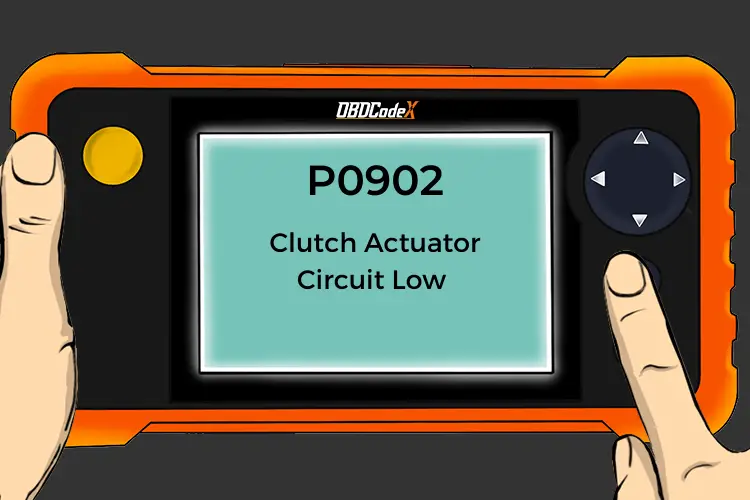P0901: Clutch Actuator Circuit Range/Performance
Is your scanner showing P0901?
No worries. We'll show you what it means and how to deal with it.
P0901: Clutch Actuator Circuit Range/Performance
OVERVIEWWhat Does The P0901 Code Mean?
OBD-II trouble code P0901 and related codes P0900, P0902, and P0903 are associated with the clutch actuator electrical circuit. This circuit is monitored by the Engine Control Module (ECM), the Power Control Module (PCM) or the Transmission Control Module (TCM) based on the specific vehicle.
The purpose of the clutch actuator circuit is to engage and disengage the clutch or clutches on a semi-automatic transmission.
Based on the specific vehicle and the configuration, several sensors and associated components are required to accomplish this task. Some configurations incorporate two hydraulic clutches, one for even gears and another for odd gears. The number of gears may range from 6 to 9 on newer vehicles. Basically, this design facilitates gear changes that are smooth and seamless operating in the same manner as a fully automatic transmission.
When the ECM, PCM or TCM detects either out-of-range or other performance problem within the voltage or resistance in the clutch actuator circuit, code P0901 will be set and the check engine light or the transmission warning lamp will be illuminated.
What Are The Symptoms Of The P0901 Code?
Symptoms of a P0901 trouble code may include:
- Motor may not crank over
- Engine may stall while driving
- Transmission may be placed into a limp mode
- Transmission may be stuck in one gear
- Transmission warning lamp illuminated
- Check engine light illuminated
What Are The Potential Causes Of The P0901 Code?
Causes for this P0901 code may include:
- Defective clutch actuator
- Defective sensor or solenoid
- Faulty or damaged wiring
- Loose or defective control module ground strap
- Corroded, damaged or loose connector
- Defective fuse or fuse-able link (If applicable)
- Clutch master cylinder malfunction
- Defective ECM, PCM or TCM
How Serious Is This P0901 Code?
The severity of this code is normally moderate, but P0901 can be severe if the vehicle is not shifting properly that may cause damage to internal transmission components.
How Can You Fix The P0901 Code?
The first step in the troubleshooting process for any malfunction is to research the Technical Service Bulletins (TSB’s) for the specific vehicle by year, model and power plant. In some circumstances, this can save a lot of time in the long run by pointing you in the right direction.
The second step is to locate all of components associated with the clutch actuator circuit and look for obvious physical damage. Perform a thorough visual inspection to check the associated wiring for obvious defects such as scraping, rubbing, bare wires, or burn spots. Next is to check the connectors and connections for security, corrosion and damaged pins. This process must include all wiring connectors and connections to all sensors, solenoids, actuators and control modules. Consult the specific tech data for the vehicle to see if a fuse or fuse-able link is incorporated into the circuit.
Advanced Steps
The advanced steps become very vehicle specific and require the appropriate advanced equipment to perform accurately. These procedures require a digital multi meter and the specific technical references for the vehicle. Specific technical data will include troubleshooting charts and the appropriate sequence to follow assisting you with an accurate diagnosis.
Voltage Checks
Voltage checks must be performed utilizing the specific troubleshooting guidelines for the vehicle to identify the proper sequence and the acceptable ranges for proper operation. This phase of the troubleshooting process will vary tremendously for different makes and models.
If this process identifies the absence of a power source or ground, continuity testing may be required to check the integrity of the wiring, connectors and other components. Continuity tests should always be performed with the power removed from the circuit and the normal readings for wiring and connections should be 0 ohms of resistance. Resistance or no continuity is an indication of faulty wiring that is open or shorted and must be repaired or replaced.
A continuity test from the ECM, PCM or TCM control to the frame will confirm the serviceability level of ground straps and ground wires. The presence of resistance is an indication of a loose connection or possible corrosion.
Recommended Parts
Below are some recommended auto parts to help you address the trouble code affecting your vehicle and get it running smoothly again:
>>> Clutch Actuator
>>> Clutch Master Cylinder
>>> WORKPRO 582-piece Crimp Terminals, Wire Connectors, Heat Shrink Tube, Electrical Repair Kit
>>> ECU
>>> KAIWEETS Digital Multimeter
Note: During the purchasing process, please check carefully whether the part you want to buy fits your car!
Reference Sources
P0901 Clutch Actuator Circuit Range/Performance, OBD-Codes.




